-
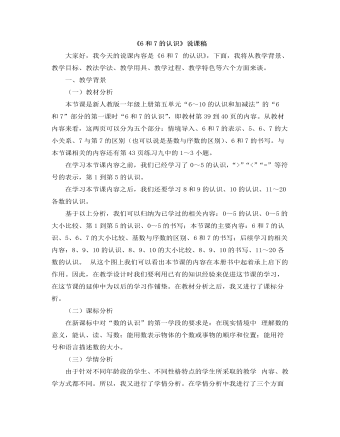
小学数学人教版一年级上册《6和7的认识》说课稿
大家好,我今天的说课内容是《6和7 的认识》,下面,我将从教学背景、教学目标、教法学法、教学用具、教学过程、教学特色等六个方面来谈。一、教学背景(一)教材分析本节课是新人教版一年级上册第五单元“6~10的认识和加减法”的“6和7”部分的第一课时“6和7的认识”,即教材第39到40页的内容。从教材内容来看,这两页可以分为五个部分:情境导入、6和7的表示、5、6、7的大小关系、7与第7的区别(也可以说是基数与序数的区别)、6和7的书写。与本节课相关的内容还有第43页练习九中的1~3小题。在学习本节课内容之前,我们已经学习了0~5的认识,“>”“<”“=”等符号的表示,第1到第5的认识。在学习本节课内容之后,我们还要学习8和9的认识、10的认识、11~20各数的认识。
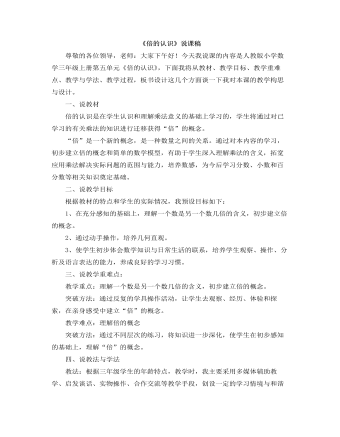
小学数学人教版三年级上册《倍的认识》说课稿
一、说教材倍的认识是在学生认识和理解乘法意义的基础上学习的,学生将通过对已学习的有关乘法的知识进行迁移获得“倍”的概念。“倍”是一个新的概念,是一种数量之间的关系。通过对本内容的学习,初步建立倍的概念和简单的数学模型,有助于学生深入理解乘法的含义,拓宽应用乘法解决实际问题的范围与能力,培养数感,为今后学习分数、小数和百分数等相关知识奠定基础。二、说教学目标根据教材的特点和学生的实际情况,我预设目标如下:1、在充分感知的基础上,理解一个数是另一个数几倍的含义,初步建立倍的概念。2、通过动手操作,培养几何直观。3、使学生初步体会数学知识与日常生活的联系,培养学生观察、操作、分析及语言表达的能力,养成良好的学习习惯。三、说教学重难点:教学重点:理解一个数是另一个数几倍的含义,初步建立倍的概念。突破方法:通过反复的学具操作活动,让学生去观察、经历、体验和探索,在亲身感受中建立“倍”的概念。
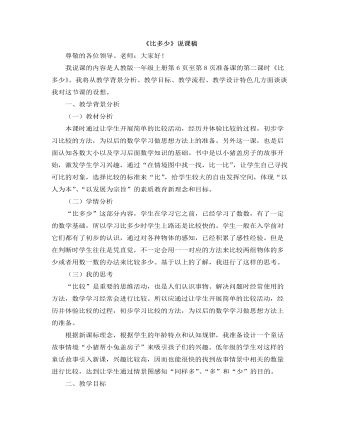
小学数学人教版一年级上册《比多少》说课稿
尊敬的各位领导、老师:大家好!我说课的内容是人教版一年级上册第6页至第8页准备课的第二课时《比多少》。我将从教学背景分析、教学目标、教学流程、教学设计特色几方面谈谈我对这节课的设想。一、教学背景分析(一)教材分析本课时通过让学生开展简单的比较活动,经历并体验比较的过程,初步学习比较的方法,为以后的数学学习做思想方法上的准备。另外这一课,也是后面认知各数大小以及学习后面数学知识的基础。书中是以小猪盖房子的故事开始,激发学生学习兴趣,通过“在情境图中找一找,比一比”,让学生自己寻找可比的对象,选择比较的标准来“比”,给学生较大的自由发挥空间,体现“以人为本”、“以发展为宗旨”的素质教育新理念和目标。(二)学情分析 “比多少”这部分内容,学生在学习它之前,已经学习了数数,有了一定的数学基础,所以学习比多少时学生上路还是比较快的。学生一般在入学前对它们都有了初步的认识,通过对各种物体的感知,已经积累了感性经验。但是在判断时学生往往是凭直觉,不一定会用一一对应的方法来比较两组物体的多少或者用数一数的办法来比较多少。基于以上的了解,我进行了这样的思考。
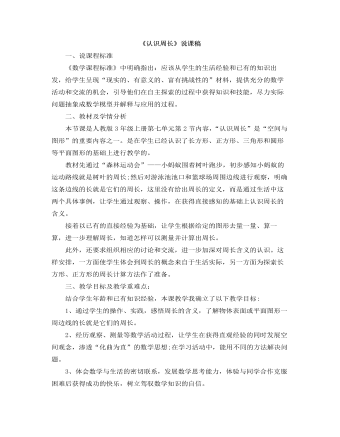
小学数学人教版三年级上册《认识周长》说课稿
一、说课程标准《数学课程标准》中明确指出:应该从学生的生活经验和已有的知识出发,给学生呈现“现实的、有意义的、富有挑战性的”材料,提供充分的数学活动和交流的机会,引导他们在自主探索的过程中获得知识和技能,尽力实际问题抽象成数学模型并解释与应用的过程。二、教材及学情分析本节课是人教版3年级上册第七单元第2节内容,“认识周长”是“空间与图形”的重要内容之一。是在学生已经认识了长方形、正方形、三角形和圆形等平面图形的基础上进行教学的。教材先通过“森林运动会”——小蚂蚁围着树叶跑步,初步感知小蚂蚁的运动路线就是树叶的周长;然后对游泳池池口和篮球场周围边线进行观察,明确这条边线的长就是它们的周长,这里没有给出周长的定义,而是通过生活中这两个具体事例,让学生通过观察、操作,在获得直接感知的基础上认识周长的含义。接着以已有的直接经验为基础,让学生根据给定的图形去量一量、算一算,进一步理解周长,知道怎样可以测量并计算出周长。
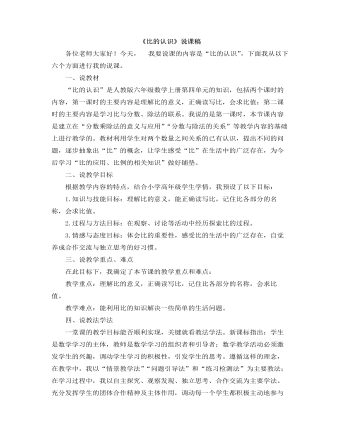
小学数学人教版六年级上册《比的认识》说课稿
五、说教学过程兴趣是学习的动力,问题是思维的核心。为了激发学生的兴趣,发展学生的思维,本节课从学生感兴趣的事物出发,始终以问题为引领,遵循“现实题材→数学问题→数学模型→数学方法→解决问题”的过程来设计教学,引导学生将实际问题抽象成数学模型,并进行探索与应用的过程,使学生逐步学会用数学知识和方法解决生活中的实际问题。根据这样的新课标设计理念,我安排了以下五个教学环节:(一)创设情境,引入比为激发学生的兴趣,我从学生感兴趣的杨利伟叔叔及其事迹出发,设置问题,逐步引入新课。同学们,认识杨利伟叔叔吗?他就是载人飞船“神舟”五号的航天员。2003年10月15日,我国第一艘载人飞船“神舟”五号顺利升空。
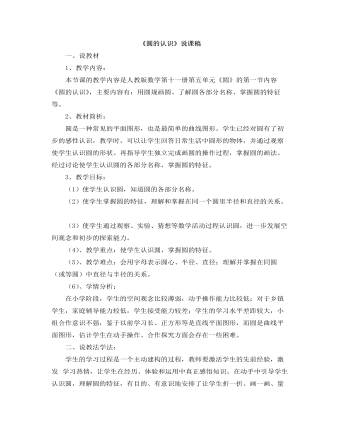
小学数学人教版六年级上册《圆的认识》说课稿
二、说教法学法:学生的学习过程是一个主动建构的过程,教师要激活学生的先前经验,激发 学习热情,让学生在经历、体验和运用中真正感悟知识。在动手中引导学生认识圆,理解圆的特征,有目的、有意识地安排了让学生折一折、画一画、量一量、比一比等动手实践活动,启发学生用眼观察,动脑思考,动口参加讨论,用心去辨析同学们的答案。教学中理应发挥学生的主体作用,淡化教师的主观影响,让学生自己在实践中产生问题意识,自己探究、尝试,修正错误,总结规律,从而主动获取知识。本节课我采用了多媒体教学手段,主要运用操作、探究、讨论、发现等教学方法。学生的学法与教法相对应,让学生主动探索、主动交流、主动提问。通过多媒体的直观演示将演示、观察、操作、思维与语言表达结合在一起,使学生对圆有一个形象的感知。同时作用于学生的感官,调动学生的学习积极性,给学生充分的时间和机会让他们主动参与获取知识的过程,培养学生自主学习的意识与创新意识。
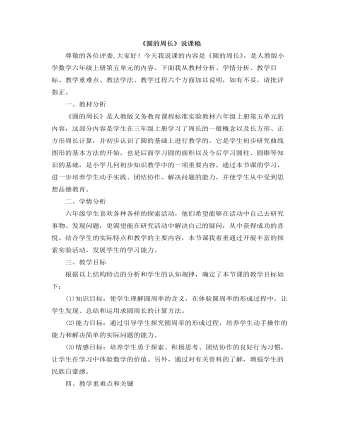
小学数学人教版六年级上册《圆的周长》说课稿
二、学情分析六年级学生喜欢各种各样的探索活动,他们希望能够在活动中自己去研究事物、发现问题,更渴望能在研究活动中解决自己的疑问,从中获得成功的喜悦。结合学生的实际特点和教学的主要内容,本节课我着重通过开展丰富的探索实验活动,发展学生的学习能力。三、教学目标根据以上结构特点的分析和学生的认知规律,确定了本节课的教学目标如下:(1)知识目标:使学生理解圆周率的含义,在体验圆周率的形成过程中,让学生发现、总结和运用求圆周长的计算方法。(2)能力目标:通过引导学生探究圆周率的形成过程,培养学生动手操作的能力和解决简单的实际问题的能力。(3)情感目标:培养学生勇于探索、积极思考、团结协作的良好行为习惯,让学生在学习中体验数学的价值。另外,通过对有关资料的了解,增强学生的民族自豪感。四、教学重难点和关键我确定本节课的重点是:推导圆周长的计算方法。教学难点是:学生以合作实践,讨论交流的方式探究圆周率的含义。
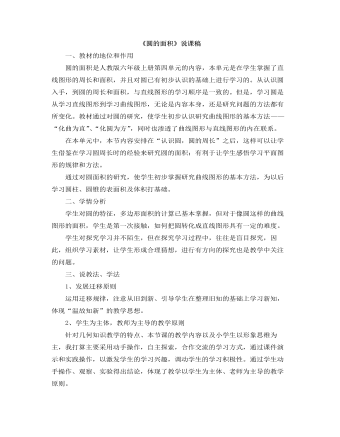
小学数学人教版六年级上册《圆的面积》说课稿
4.学生的学习活动不仅是为了获得知识,而更重要的是掌握获得知识的方法。本节课我以培养学生的实践能力、探索能力和创新精神为目标。在教学过程中,我培养学生初步感知和运用转化的方法,引导学生通过观察、比较、操作、概括等行为来解决新问题,通过一系列活动,培养学生动手、动口、动脑的能力,使学生的观察能力、操作能力、抽象概括能力逐步提高,教会学生学习。四、说教学目标知识目标:理解和掌握圆面积的计算公式,能应用公式解决实际问题。能力目标:进一步培养学生合作探究、分析概括,以及迁移类推的能力。情感目标:通过演示、操作,进一步让学生体验到数学来源于生活,又服务于生活的理念;唤起学生学习数学的兴趣,使全体学生积极参与探索,在参与中体验成功的乐趣。
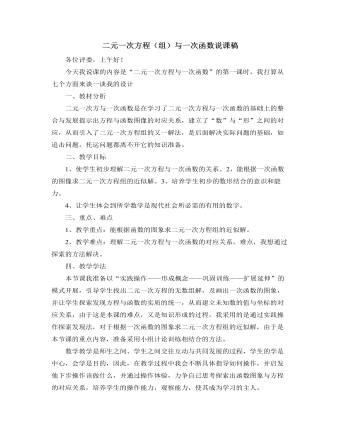
北师大版初中八年级数学上册二元一次方程(组)与一次函数说课稿
在第1环节基础上,再让同学认识到函数Y=2X-1的图象与方程2X-Y=1的对应关系,从而把两个方程组成方程组,让学生在理解二元一次方程与函数对应的基础上认识到方程组的解与交点坐标的对应关系,从而引出二元一次方程组的图象解法。3、例题训练,知识系统化通过书上的例1,用作图象的方法解方程组,让学生明白解题步骤与格式,从而规范理顺所学的图象法解方程组,例题由师生合作完成,由学生说老师写的方式。4、操作演练、形成技能让学生独立完成书P208随堂练习,给定时间,等多数学生完成后,实物投影其完成情况,并作出分析与评价。5、变式训练,延伸扩展通过让学生做收上P208的试一试,而后给一定时间相互交流,并请代表发言他的所悟,然而老师归纳总结,并让学生通过自已尝试与老师的点拔从“数”与“形”两个方面初步体会某些方程组的无解性,进一步发展学生数形结合的意识和能力。6、检测评价,课题作业

人教版新目标初中英语七年级下册I ’d like some noodles教案
教学过程Step 1: warming-up Sing a song---------“food and drink” Step 2: Revision1 Dictation2 Revise: What kind of noodles would you like?I’d like …What size bowl of noodles would you like?I’d like…Step 3: Presentation1 show pictures of food, ask students say the words.2 Students read the newspaper ad in 3a. Fill in blanks with words in the box. Then read the ad together, the teacher explains some difficult language points.3 Check the answers Step 4 PracticeAsk students to finish 3b in the same way according to 3a. Students read the short passage and fill in the blanks .At last, check the answers.Step 5 productionAsk students to write their own ad for dumplings, noodles, drinks, and other foods they know. Then ask students to read their partner’s ad. Then order food and drink from their partner.Step 6 Home workGroup work – make an ad about “food and drink”

人教版新目标初中英语七年级下册It’s raining教案2篇
1 Each group choose one place to describe and what you are doing in it Choose one place, and describe what they are doing 2 Move around the room and give suggestions Talk about it and write it down 3 Ask one to show their works and act it Choose one of each group to make a report 4 Evaluate the best group and the best reporter Choose the best one Homework Ask your friends their ideal place and write about it教学反思:新课程标准中强调学生在课堂中的主体地位,在综合课中他们的主体地位就更加突出。在各个活动中给不同程度的学生不同层次的任务,让各层面的学生都有表现发挥的机会,从而产生对英语的兴趣。使用照片图片多媒体来辅助教学,效果更好。同时让了解其他国家风景,风俗的同学介绍ideal place,增加学生的背景知知识,实现跨学科交流的目的。教案点评:采用任务型教学模式,在各个活动中给不同程度的学生不同层次的任务,让各层面的学生都有表现发挥的机会,从而产生对英语的兴趣。使用照片图片多媒体来辅助教学,效果更好。让了解其他国家风景,风俗的同学介绍ideal place,增加学生的背景知识,实现跨学科交流的目的。

人教版新目标初中英语七年级下册Where is your pen pal from教案
2.1Match the country with the language.Step II Reading3a? let the students read the letter fast and answer the questions.? Let the students ask more questions about the letter as possible as the can.Step III Writing3b.Step IV. Pairwork2cStep V Listening2a, 2bStep V. HomeworkExercises book(1) P3Exercises book (2) P3Period FourStep I . Dictate the words and sentences in Unit1.Step II. Self-checkStep III. Check the answers for Exercises book in the unit.Step IV. Home workRevise and preparation for unit 2.教学反思:通过本单元的学习,学生基本可以谈论人们的国籍,居住城市及其所说的语言,通过书信方式去介绍自己并寻找笔友。但在涉及到国外的一些城市时,学生对这方面的知识相对欠缺,能介绍的城市并不多,也反应出学生课前预习不充分,这跟学生学习条件也有关,大多数学生无法通过网络获取所需信息。因此,在以后的教学中要多指导学生通过计算机网络获取信息,拓宽知识面。

人教版新目标初中英语七年级下册What do you think of game shows教案
五、教学Section B-2c1. Pair work: What do you think of the belt/sunglasses/…? What does your father/mother/… think of your scarf/belt…?2. Group work(1). Teacher shows some different kinds of school uniforms (制服)and asks : “ What do you think of your school uniforms? If you have a chance to choose your school uniforms, what kind would you like to choose?”(2). Discuss in groups.(3).Get some Ss to report in class.说明:这一步旨在让学生运用已有的语言知识谈论对事物的看法和意见,并简单阐明理由,培养学生的主动思维能力和运用英语的能力。六、教学拓展调查电视节目的收视率任务:调查你周围的人对现在各种电视节目的反响。活动过程:1.教师布置任务,让学生调查周围的人(包括他的亲戚朋友和邻居)喜欢收看哪方面的电视节目。2.学生进行调查活动,运用本单元所学的句型What do you think of….? (Why?)What's your favorite game shows?What do you think of talk show?I doesn’t mind it.I like it.I love it.I can’t stand it.3.记录下排在前10位的TV Program,填写调查表,比较其收视率。

人教版新目标初中英语七年级下册Where did you go on vacation教案
句型: Where did you go on vacation? I went to summer camp.Did she go to Central Park?Yes,she did.No, she didn’t语法:一般过去时特殊疑问句、一般疑问句及肯、否定回答。课时安排4课时第一课时:Section A:la,1b,lc,2a,2b,2c 第二课时:Section A:3a,3b,4第三课时:Section B:1,2a,2b,2c第四课时:Section B:3a,3b,3c,4 and Self Check第一课时教学目标掌握描写假期生活的形容词。假期里自己所做事情的简单表达。谈论假期做的事情及当时情况。谈论假期时旅游的天气,旅游者以及食物等。教学过程一、导入播放一首英文歌曲:Let’s travel 说明:通过让学生听节奏欢快迪斯尼英语歌曲Let’s travel.引入本节课谈论的话题vacation and travel. 让歌曲使学生的思维活跃,增强课堂气氛,激发学生提高学习英语的兴趣。T:How is the trip ?Ss : It’s pretty good/ happy/exciting /relaxing/busy/dangerous/ fantastic说明:这个问题是为了操练形容词。建议让多个Ss作答。鼓励他们用不同的形容词。上述个别形容词本应在第二课时中出现,但可以在warming-up中第一次非正式出现。这些形容词也可在老师的评价语中适时出现,以加深学生对词汇的印象。

人教版新目标初中英语七年级下册Why do you like koalas教案2篇
单元整体说明(一)单元教材分析本单元的核心话题是描述动物和表达个人喜好,以及句式why do you like…? Because…。这也是本单元的教学重点。通过本单元的学习,学生应能较流利地运用所学词汇和句型描述动物,表达个人喜好。(二)单元知识结构1.词汇动物名称 tiger, elephant, koala, dolphin, etc.词汇描述性形容词: smart, cute, ugly, clever, shy, etc.国家名: Australia, South Africa2.句型Why do you like koala hears? Because they are cute.Where are pandas from? They're from China.What animals do you like? I like dolphins.(三)单元整体目标1.Master the vocabulary2.Master and use: Why do you like koalas? Because they am cute.Where are pandas from? They're from China.What animals do you like? I like dolphins.(四)单元教学重难点一览(五)单元学情分析学生此前已经学过由why, where, what 引导的特殊疑问句句型,具有了学习本单元知识的认知前提。形形色色的动物能激发学生的好奇心,产生了解它们的欲望,这有利于本单元知识的教学和学生学习兴趣的培养。

人教版新目标初中英语八年级下册It’s a nice day, isn’t it教案2篇
"Hello! Welcome to English class! Introduce yourself. Meet your new classmates." That's what the teacher says. What do you say? "Oh no!" It can be difficult talking to new people. But it can be fun, and you can make friends. How do you do it? Make small talk. Small talk is polite conversation. "Wang Nan is a great pingpang player, isn't she?" "I'd love to meet her, wouldn't you?" "It's been raining a lot, hasn't it?" Tag questions are a form of polite speech. To make small talk successfully, you should know how to make them. You should also know what topics to talk about. Try to learn this unit carefully. The next time you're in English class, you'll find out. Making small talk's easy, isn't it? (“你好!欢迎你!请做一下自我介绍。认识一下你的新同学。”通常在课上老师会这样说。你会说什么呢?“噢,不!”与陌生人谈话太困难了。但是这也很有意思,并且你还能交到朋友。你该怎么做呢?闲聊。闲聊指得是礼貌的对话。“王楠是一个很棒的乒乓球运动员,不是吗?”“我希望自己能认识她,你呢?“今年的雨水很多,不是吗?”反意疑问句是一种礼貌用语。为了使得谈话成功,你应该知道怎样去进行闲聊。你还应该知道与不同的人该谈论什么样的话题。认真的学习这个单元吧,下次在英语课上,你会发现与大家展开谈话是一件很容易的事情,不信我们来试试。)

人教版新目标初中英语八年级下册He said I was hard-working教案2篇
This activity introduces some new vocabulary and provide oral practice using the target language.Task 1 . Ask four students to stand in front of the class, and the teacher asks them the following questions as a reporter.1.What are you going to do when you grow up?2.What are you going to do next week?3.What are going to do after school?The students will give different answers, then ask a good student to report what they said.I am going to e a doctor.What did she say?----------She said she was going to be a doctor.I am going to have a party on Friday night.What did he say?-------He said he was going to have a party on Friday night.I am going to do my homework.What did she say ?------ She said she was going to do her homework.I am going home after school.What did she say?-----She said she was going home after school.Say In this unit we are going to learn to use words like to report what someone said.Task 2. Read the instructions. Then ask a student to read the four questions. And write the words on the Bb. Explain what soap opera is.Task 3. Ask the students to Look at the pictures, point out the TV screens in the picture. Ask one girl to read what Marcia said.What did Marcia say? She said She said she was having a surprise party for Lana on Friday night. Repeat the other pictures in the same way.Activity3. Listen and number the pictures in activity 1a.

人教版新目标初中英语八年级下册How long have you been collecting shells教案2篇
Step Ⅱ Show the new words on the screen and teach the new words. Read the new words to students and ask them to repeat.Step Ⅲ 3aThis activity introduces new vocabulary and provides reading practice using the target language.In this activity first look at the four pictures.T: What can you see in the pictures?Ss: Four snow globes.T: Right. There are four snow globes in the pictures. And what are they?Ss: They are a monster, two polar bears, two penguins and a birthday cake.Write these words on the blackboard: snow globe; monster; polar bear; penguin and birthday cake. Read them to the class and ask students to repeat each one. Make sure students understand each word.Use a computer to show the E-mail message on the screen and read the message to students.Get students to read the e-mail on their own, and then draw lines connecting each snow globe and its description.Correct the answers.AnswersA line should connect each snow globe picture with the words that describe it in the letter.Step Ⅳ 3bThis activity provides writing practice using the target language.First review Activity 2a on Page 47.Then ask students to complete the message according to Activity 2a.Some partial sentences are given to students. Write about one person's collection.When students work, walk around the room checking the progress and offering help as needed.When they finish, ask some students to read their messages to the class.

人教版新目标初中英语八年级下册Why don’t you get her a scarf教案
教师带领学生复习有关描述宠物的词汇,采用教师提问学生回答的方进行。如:T:What animals do you think would be good pets?What animals do you think would be bad pets?What do you think are good animals for a six-year-old child?然后学生进行 pairwork 练习。Task two: 师生互动,学习探究 1、播放3a部分的录音,引导学生一边听录音,一边跟读。2、通过听录音学生回答以下问题:Why do you think pot-bellied pigs are popular?What are the advantages and disadvantages of keeping such a pet?教师对学生的回答进行及时点评。3.学习范文,学习重点短语,为下步的模仿写作提供语言素材。T :1. )Have you ever kept a pig as a pet?Do you like pigs? St.:No.…Why don’t you like to keep a pig? St: No.They’re too dirty and lazy(Do you know in some foreign countries like Hollyland, Australia,pigs are the most popular pet.there’s a kind of pig.(图)it has an interesting name? it ‘s called a pot-bellied pig.) Now,let’s learn an article about this kind of interesting pet.2.)play the tapeSt.:Listen and repeat3.)show some Qs on computer(本子St.: read silently,then answerthe Qs(本子)4.)Ask ss. Close book and retell this passage.(what is a pot-bellied pig? Is it a good or bad pet? ) St.: retell it to each other“A pot –bellied pig is a popular pet now…”5.read the article together.St.:.practice reading

人教版新目标初中英语七年级下册How was your weekend教案2篇
Teaching Goal:1. General aims:Talk about recent past events2. Particular aims:A. Language Focus.Talk about recent past events and think of the past events.B. Language goalsHow was….?It was …What did …do over the weekend?C. Language structures:(1). How was your weekend? I was great. Pay attention to no form.(2). What did you do over the weekend? I played soccer. We went to the beach.D. Useful words and phrases:Words: was, did, went, beach, over, project, test, wasn’t, false, number, geography, spend, week, most, mixture, their, had, little, cook, read, saw, change, everyone, sit, sat, no, anythingPhrases: did one’s homework, played soccer, cleaned my room, went to the beach, played tennis, went to the movies, on Saturday morning, over the weekend, cook … for, what about, do some reading, have a party, talk show, go shoppingE. Grammar language:Present simple past tenseRegular and irregular verbsF. Learning strategies:Tour and holidaysG. Interdiscipinary:H. Emotion and manner:Teaching time: 5 periodsTeaching procedures:Period One教学步骤、时间 教师活动 学生活动 媒体应用Step 1Free talk 3’ Ask some questions like:Who’s on duty today?What’s the weather like? Answer and talk about something.让同学们回答下列问题1. Do you like weekend? (Let some students answer)It takes them three minutes to talk about the question.2. Why do you like weekend? (let the students answer) Most of the students like the weekend此时教师用汉语问:“在周末期间问你干了什么?这句话用英语这么回答?Let the students guess.At last the teacher give them right answer3. What did you do over the weekend?(板书、学习)

